Menus
- What makes you fast
- Background information about the fall in the video:
- Prices and offers of the very latest super athletes in Germany
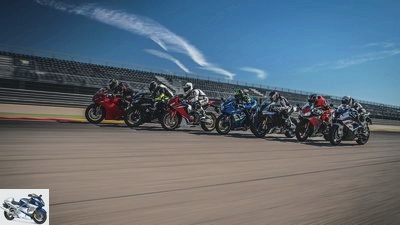
r-photography.info
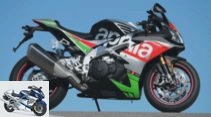
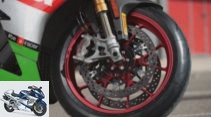
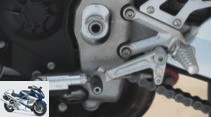
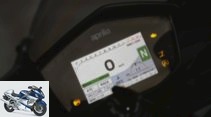
46 photos
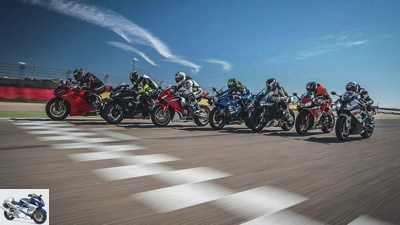
r-photography.info
1/46
Aprilia RSV4 RF, BMW S 1000 RR, Ducati 1299 Panigale S, Honda Fireblade SP, Kawasaki ZX-10RR, Suzuki GSX-R 1000 R and Yamaha YZF-R1M in the comparison test
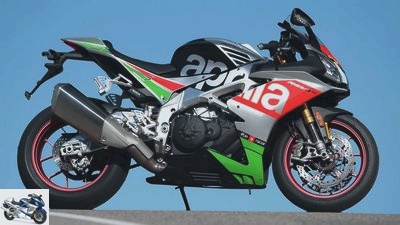
r-photography.info
2/46
Aprilia RSV4 RF in comparison test.
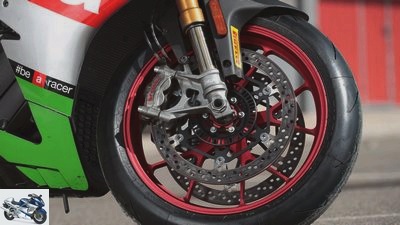
r-photography.info
3/46
Aprilia RSV4 RF: 330 mm discs, Brembo M50, Ohlins NIX, light forged wheels
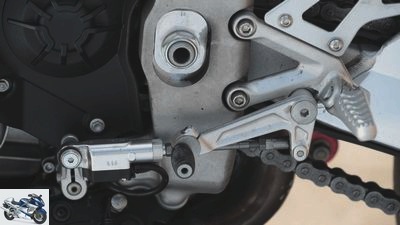
r-photography.info
4/46
Aprilia RSV4 RF: Variable pivot point, excellent blipper
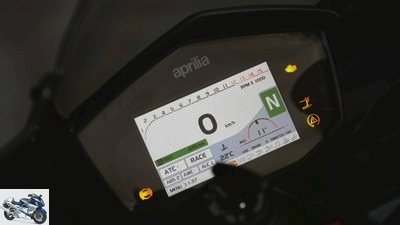
r-photography.info
5/46
Aprilia RSV4 RF: Easily readable TFT cockpit, it recently even shows the incline.
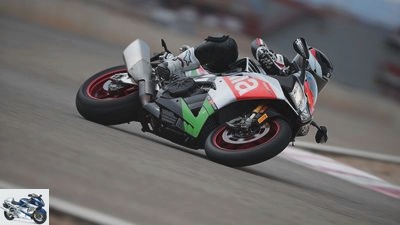
r-photography.info
6/46
Aprilia RSV4 RF in comparison test.
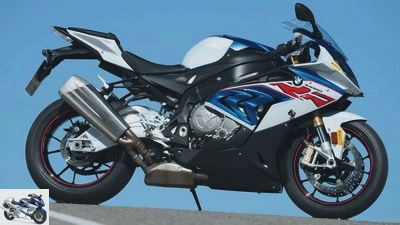
r-photography.info
7/46
BMW S 1000 RR in a comparison test.
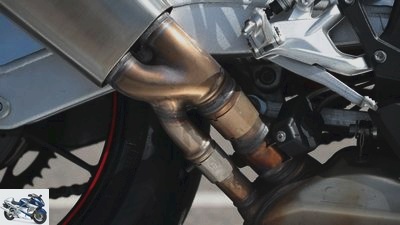
r-photography.info
8/46
BMW S 1000 RR: Bypass: The thinner pipe is always open, the flap is in the thicker one
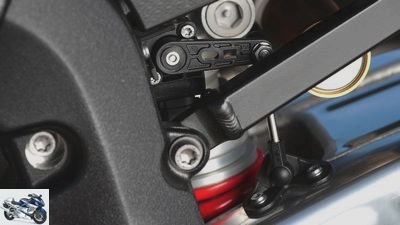
r-photography.info
9/46
BMW S 1000 RR: Suspension travel sensors use the IMU to inform the semi-active chassis
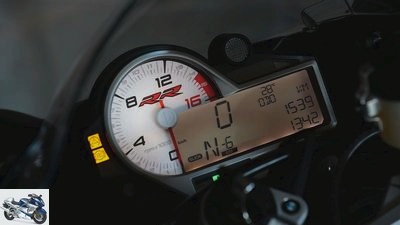
r-photography.info
10/46
BMW S 1000 RR: Good cockpit with a large rev counter, somewhat cumbersome menus
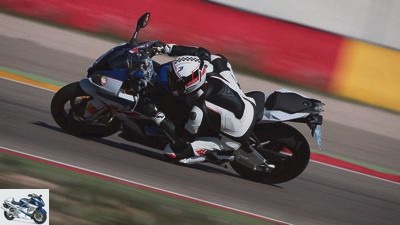
r-photography.info
11/46
BMW S 1000 RR in a comparison test.
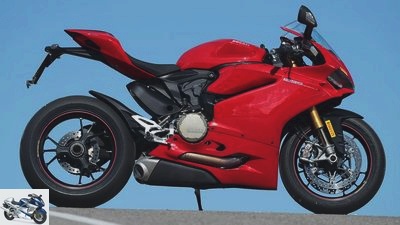
r-photography.info
12/46
Ducati 1299 Panigale S in comparison test.
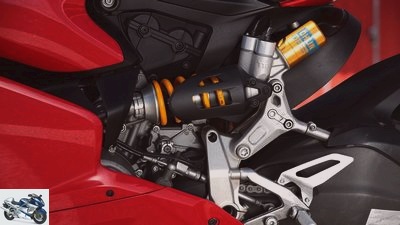
r-photography.info
13/46
Ducati 1299 Panigale S: Semi-active Ohlins shock absorber with adjustable progression.
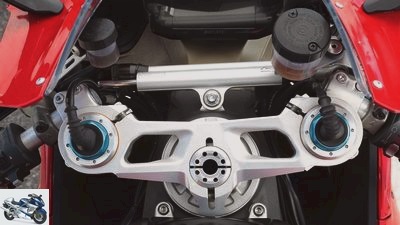
r-photography.info
14/46
Ducati 1299 Panigale S: Solid steering head, filigree triple clamp, electronic steering damper.

r-photography.info
15/46
Ducati 1299 Panigale S: easy to read, intuitive operation, dozens of display options.
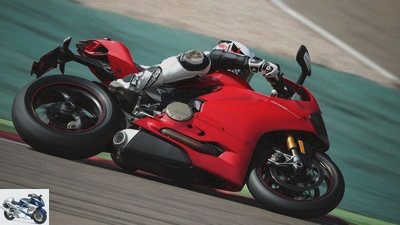
r-photography.info
16/46
Ducati 1299 Panigale S in comparison test.

r-photography.info
17/46
Honda Fireblade SP in comparison test.
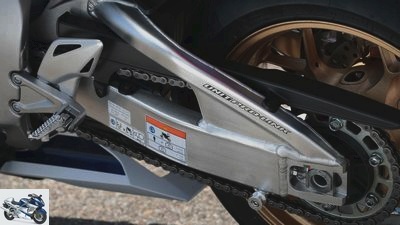
r-photography.info
18/46
Honda Fireblade SP: The Fireblade’s swingarm is finely crafted and powerful.
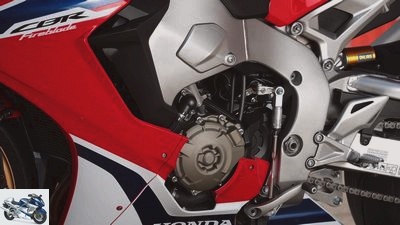
r-photography.info
19/46
Honda Fireblade SP: The equally powerful frame encloses the engine extensively.
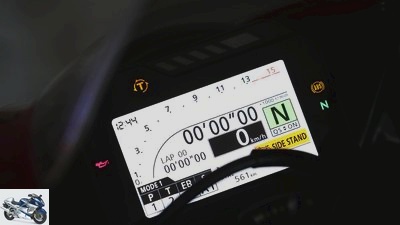
r-photography.info
20/46
Honda Fireblade SP: Honda now also relies on TFT. Readability good, operation okay.
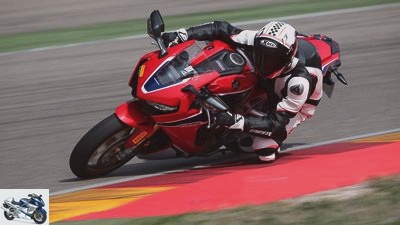
r-photography.info
21/46
Honda Fireblade SP in comparison test.
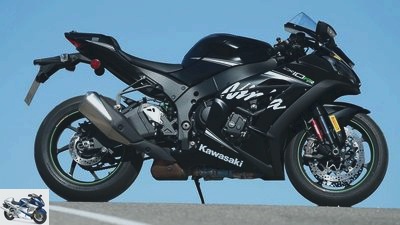
r-photography.info
22/46
Kawasaki ZX-10RR in comparison test.
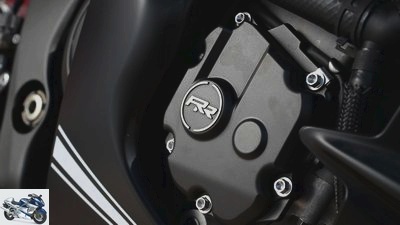
r-photography.info
23/46
Kawasaki ZX-10RR: Modified on the double R: crankcase and cylinder head.
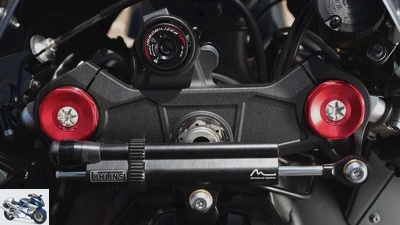
r-photography.info
24/46
Kawasaki ZX-10RR: conventional Showa fork, electronic steering damper.
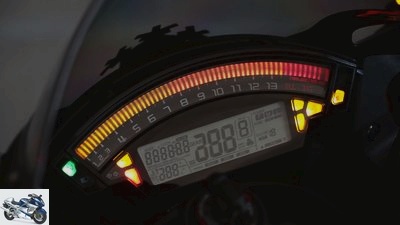
r-photography.info
25/46
Kawasaki ZX-10RR: Excellent readable tachometer, cheap looking LCD display.

r-photography.info
26/46
Kawasaki ZX-10RR in comparison test.
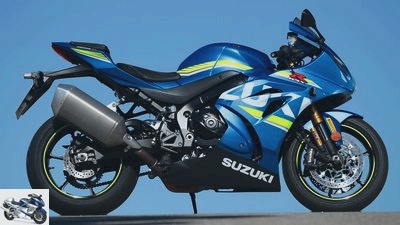
r-photography.info
27/46
Suzuki GSX-R 1000 R in comparison test.

r-photography.info
28/46
Suzuki GSX-R 1000 R: BFF fork (only in R version), Brembo M50, T-drive discs (320 mm).
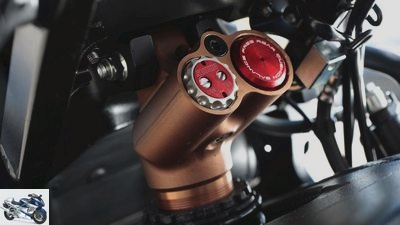
r-photography.info
29/46
Suzuki GSX-R 1000 R: A twin-tube damper from Showa, called “Balance Free Rear Cushion”.
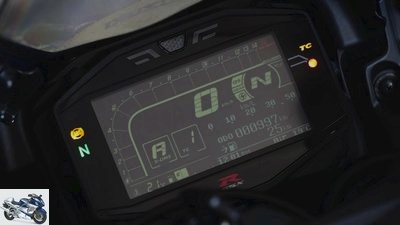
r-photography.info
30/46
Suzuki GSX-R 1000 R: The Suzuki’s LCD cockpit is unconventional but functional.
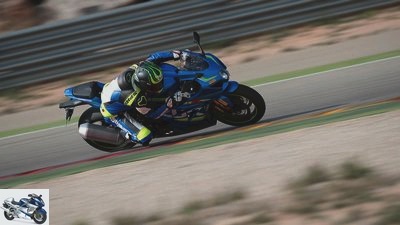
r-photography.info
31/46
Suzuki GSX-R 1000 R in comparison test.
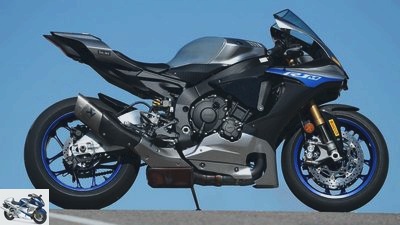
r-photography.info
32/46
Yamaha YZF-R1M in comparison test.
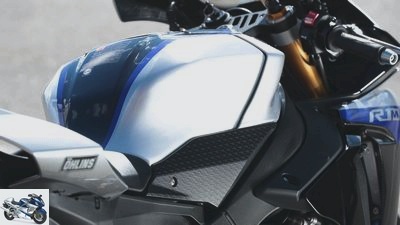
r-photography.info
33/46
Yamaha YZF-R1M: Noble, high-quality appearance, not only thanks to the visible aluminum tank.
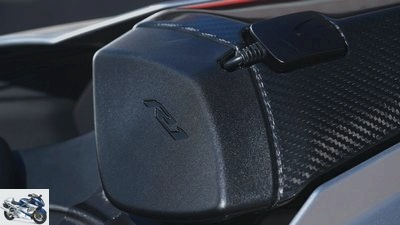
r-photography.info
34/46
Yamaha YZF-R1M: A lot of carbon fiber on the R1M, plus an integrated data recording.
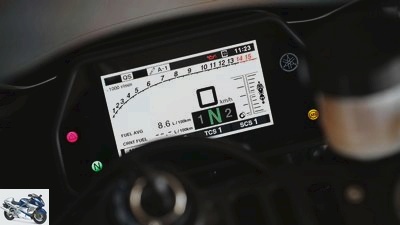
r-photography.info
35/46
Yamaha YZF-R1M: Great TFT display with many options and conclusive usability.

r-photography.info
36/46
Yamaha YZF-R1M in comparison test.
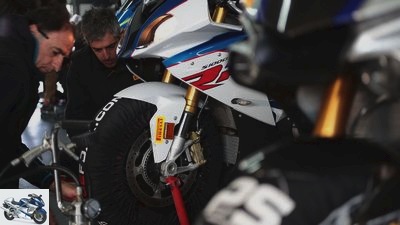
r-photography.info
37/46
Science and logistics: tire temperatures and air pressures, running images, data recording – and always fresh Pirellis
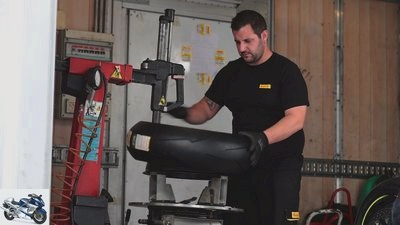
r-photography.info
38/46
Aprilia RSV4 RF, BMW S 1000 RR, Ducati 1299 Panigale S, Honda Fireblade SP, Kawasaki ZX-10RR, Suzuki GSX-R 1000 R and Yamaha YZF-R1M in the comparison test
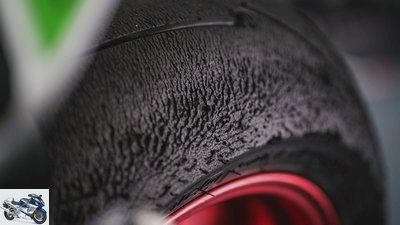
r-photography.info
39/46
Aprilia RSV4 RF, BMW S 1000 RR, Ducati 1299 Panigale S, Honda Fireblade SP, Kawasaki ZX-10RR, Suzuki GSX-R 1000 R and Yamaha YZF-R1M in the comparison test

r-photography.info
40/46
Aprilia RSV4 RF, BMW S 1000 RR, Ducati 1299 Panigale S, Honda Fireblade SP, Kawasaki ZX-10RR, Suzuki GSX-R 1000 R and Yamaha YZF-R1M in comparison test

r-photography.info
41/46
Close together, …
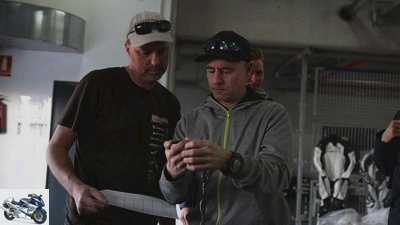
r-photography.info
42/46
…but the clock shows a different order.

r-photography.info
43/46
Scenes of a track test: finish on start-finish, …
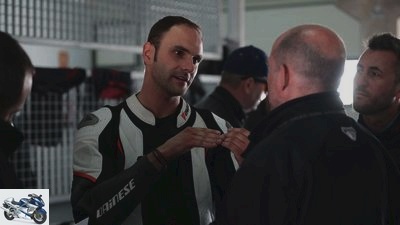
r-photography.info
44/46
…Death explained…,
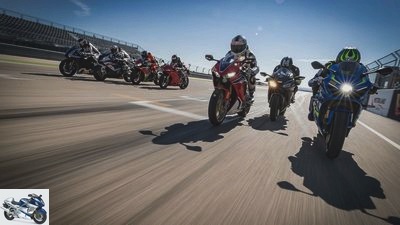
r-photography.info
45/46
…Formation flight in Aragón…
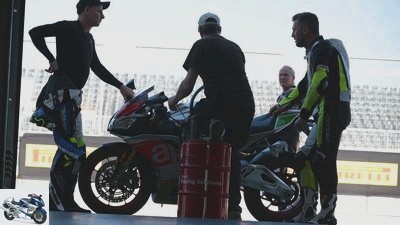
r-photography.info
46/46
…and refueling again and again.
Seven superbikes in the racetrack test
What makes you fast
Seven fine superbikes, two Spanish race tracks: Honda Fireblade SP, Aprilia RSV4 RF, Suzuki GSX-R 1000 R, Ducati 1299 Panigale S, Kawasaki ZX-10RR, Yamaha YZF-R1M and BMW S 1000 RR in the track test.
For the 2017 mega-track test of the athletes, the stars gathered in a particularly happy constellation in the sky: Honda delivered the brand-new Fireblade SP to MOTORRAD just in time. Suzuki flew in a copy of the GSX-R 1000 R recently presented at Phillip Island from Japan. The recently sharpened Aprilia R.SV4 RF came to the racetrack from Italy directly from the presentation by van. The Yamaha YZF-R1M, Kawasaki ZX-10RR and the BMW S 1000 RR are the very first test machines delivered according to the Euro 4 update. This comparison is important and everyone wants to be part of it. Also the Ducati 1299 Panigale S, which, admittedly, is a little out of the ordinary. It treats itself to a full increase in displacement, is still homologated according to Euro 3 and is therefore a sales model. But if she weren’t there, the fast red from Bologna, she would be missing. RF, S, SP, RR, R, M: The model names indicate that – with the exception of the BMW, which has been upgraded with accessory packages – only superbikes with a higher level of equipment will compete. We use the World Cup circuit Motorland Aragón and the Circuito de Alcarràs as testing grounds. Aragón, the realm of fast floating, with its largely wide, fluid radii, gourmet asphalt and a long straight, at the end of which the GPS recording with a professional in the saddle of a 200 hp machine shows a breathtaking 290 kilometers per hour perfect to explore the potential of this field. Arne Tode, a former Moto2 rider and two-time IDM Supersport champion, is there for meaningful times and test impressions, very close to the limit. The route in Alcarràs is far less pleasant: tighter, sometimes nasty turns, pocky asphalt (but a lot of grip), the nasty downhill double left courage curve, a wicked chicane and a straight, so undulating that the wheelie controls also in the fourth Gear can be tested extensively. More trench warfare than floating, but all the more suitable for uncovering even the smallest inadequacies and weaknesses.
Buy complete article
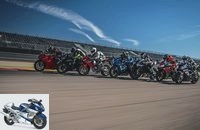
Seven superbikes in the racetrack test
What makes you fast
S 1000 RR bring it with you? Finally: Where do the long-awaited newcomers Fireblade SP and GSX-R 1000 R line up in the field??
The RSV4 RF, winner of last year’s comparison, provides a first reference. In fact, Arne Tode also manages the best lap time in Aragón on it: 1: 59.5 min. As consistently as no other motorcycle in this field, the Aprilia only wants one thing, namely to be fast on the racetrack, in line with the self-imposed claim of the developers. The seating position is uncompromisingly sporty: very high at the rear (845 millimeters seat height), low handlebars at the front, board-hard seat. This and a very compact design with a short tank result in excellent freedom of movement for the jockey. It should, no, but it must also use it. Those who do not dive deep into the corners, as it were inside next to the front wheel, only use their potential for fast cornering to a small extent. But those who put their own physical effort into this comfort-free and filter-free ergonomics will enjoy a crystal clear feeling for the grip and the reactions of the front tire. The RSV4 encourages you to take more speed into the curve, to consistently look for the narrow line at the apex of the curve in order to position the motorcycle at an early stage so that the optimal path for it
tearing out accelerating is open. A not so mundane finding: cornering speed makes you fast. Even before and after the curve.
In this point the Aprilia and the Yamaha show great similarities up to exactly identical lap times. The R1M also places its riders high at the back and low at the front – the middle of the handlebars is only about two centimeters above the seat. It also rewards those who can come to terms with it with brilliant turning behavior and fascinating precision. In contrast to the Aprilia, the suspension of the Yamaha is more “friendly”. The new deflection system of the current RSV4 acts in spite of a softer spring in the rear Ohlins damper with merciless hardness, while the R1M with its electronically controlled damping and excellent basic set-up irons the waves tightly but docile. Thanks to the semi-active damping control, the M version of the R1 shows the typical rise of the rear when braking sharply – it is due to the easy-to-use, extremely short wheelbase – only in a moderated form. More compression damping at the front and less pulling damping at the rear improve the braking stability, and an additional lifting of the front section in the triple clamps by the testers further mitigates a rear wheel that is dancing on the brakes. Incidentally, all seven machines have extremely stable braking systems that make the front tires sweat and defensively tuned, non-disengageable anti-lock devices in distress. Among them, however, the Yamaha stands out with its particularly fine, sucking-licking metering and crystal-clear pressure point.
At the level at which the R1M and RSV4 RF operate, differences in engine power and torque are of secondary importance. The Yamaha can almost always be driven in the range over 7000 rpm, i.e. above the torque lull, and the Aprilia cannot noticeably benefit from its slightly higher peak performance.
Behind the two fastest, who were good for lap times of less than two minutes, a group of three with 2:00 times crossed the finish line closely together. This alone would not be a reason to put BMW, Honda and Ducati behind Aprilia and Yamaha in the circuit points classification. But in the lap time shootout, each of the three two-minute burners revealed in a pointed form and in their own way what costs them a tenth of a second or two compared to the top duo.
With the BMW S 1000 RR, as in previous years, these are the seating position and the chassis, especially the rear suspension and damping. The measured seat height provides an important indication of this. At 820 millimeters, the BMW is one of the lowest, apart from the Kawasaki ZX-10RR, on which you sit five millimeters lower. Because current super sports bikes with racing tires can easily be inclined by more than 50 degrees, the footrests must not be mounted too low. The combination of these two properties inevitably results in a more passive sitting position on the BMW, which makes it difficult to brace yourself at the exit of the curve against the massive propulsion. In addition, there was a noticeable stirring of the hindquarters when accelerating, which could not be stopped in this test, despite further adjustment experiments with the semi-active damping. Because the BMW rolled on heavier standard bikes differently than in 2016, it seemed even a little more pronounced. A slight but noticeable tendency to pull outwards when accelerating in an inclined position, as well as robust stirring movements in the steering when transitioning to the straight line are the result and dampen the driver’s thirst for action. The S 1000 RR also lacks a little engine braking torque in the downhill sections, which calls for attention to carefully apply the rear brake. In contrast to last year, however, the BMW brake stood like a one this time. The testers were spared fading or a shifting pressure point.
Ultimately, the enormously powerful, smoothly deploying BMW four-cylinder ensures a respectable lap time. It is exactly the opposite with the Fireblade SP. Despite a noticeable performance deficit, it has almost the same time as the BMW. If one consults the original, finely resolved recording records to investigate the cause, a similar picture emerges as with the Aprilia and the Yamaha. With express surcharge. For comparison: In the downhill section known as the Corkscrew, the Yamaha was 93.3 km / h at the slowest point, the Honda 98 km / h. The right-left chicane in front of the downhill straight swept through the R1M with 92 km / h, the Fireblade with 97 km / h. This gave it such momentum on the straight that it only lost 5 km / h at top speed to the much more powerful R1M and at least reached 285 km / h.
On the angled route from Alcarràs, the handling advantage of the Honda becomes even more apparent; she achieved the second fastest lap time under top tester Karsten Schwers and two other drivers behind the BMW. Obviously you need either a brute engine or an impressive chassis. It is impossible to imagine the rocket that would result if BMW and Honda brought together their respective findings in engine and chassis construction.
Just don’t let anyone assume that they just have to buy a Fireblade SP and get the fast laps for free. Thanks to its less radical seating position and even more compact design, it drives more comfortably than the Aprilia and Yamaha, but it is extremely sensitive to handling. Accordingly, the driver’s steering and movement impulses should be just as sensitive and precise, the same applies to pulling the throttle grip in the middle of the curve. A relatively large amount of play in the drive train causes severe load change jolts when the cable is pulled with the rough motor, which immediately irritates the sensitive chassis. Not exactly what you would like to have in a fully inclined position. Setting the shift assistant to the highest sensitivity helps to reduce steering influences when shifting through quickly.
While the tuning of the semi-active damping of the Honda, similar to the Yamaha, is immediately satisfactory, the traction control, which is initially on a medium level, slows down the forward thrust too much. You quickly end up in the two sharpest levels. In Aragón, level two fit, in Alcarràs it even had to be level one because of the many bumps. Levels three to eight can only be used in the rain, their control behavior is too defensive in normal conditions.
The tuning of the Honda ABS was also a bit too cautious, but without the possibility of adjustment. All drivers would have gladly adapted the anti-lock device to the enormous grip of the racing tires or at least switched it off, because time and again the system considered safely achievable decelerations to be dangerous and therefore reduced the braking force over a long period of time. The Aprilia, BMW and Ducati can be adjusted in fine steps to the conditions on the racetrack, if desired their ABS can be partially or even completely switched off. Unfortunately, the security concerns of all four Japanese manufacturers do not allow this. The Fireblade does not even have the option of deactivating the ABS by pulling a fuse, as this would put the entire electronics out of operation. An inexpensive dongle for switching off the rear wheel or the entire ABS, as offered for around 25 euros for the Kawasaki ZX-10R (please enclose it next time!), Is also not available. From our point of view this is excessive caution, which does not lead to more, but to less safety on the racetrack. Super athletes of the caliber of our test motorcycles should enable adjustments that bring a gain in active safety on the racetrack.
In this respect, as mentioned, the Panigale S makes a perfect impression. Not only can the ABS simply be deactivated via the menu, it is calibrated to such a high level and gets along so well with the racing tires that it didn’t even seem necessary. The same applies to its traction control: it can be adjusted in fine steps from the handlebar end and while driving. A welcome feature, especially when the rear tire reaches the end of its life in the middle of a turn. Which can definitely happen once on the 1299. Because its powerful Superquadro-Testastretta-Desmo-L-Twin (yes, they can have nice names in Italy) shovels wheelbarrow-by-wheel torque to the rear end of the single-sided swing arm. With measured 201 PS and a peak of 140 Newton meters, the 1300 (admittedly still homologated according to Euro 3) stands perfectly in the feed, not only nibbling semi-slicks, but also intermediate straights with inimitable punch. As we have already established, however, unconditional performance alone does not make you fast. The Duc provides its brisk start in a finely adjustable manner, but with its violent increase in torque at around 7500 tours, which needs to be carefully internalized, it saps the stamina of the pilot. Almost more than the rock-hard Aprilia (and with some cutbacks the sensitive Honda), the 1299 S demands knowledgeable, experienced guidance. The reasons for this are on the one hand the completely different switching points that need to be completely re-sorted in the case of the only two-cylinder in the field. But you can’t blame Ducati for that, it’s in the nature of things. On the other hand, and this is the main point of criticism, your semi-active Ohlins chassis does not work “out of the box” with the same aplomb as the systems from Honda and Yamaha. An unexpected amount of movement, especially over bumps in an inclined position and when accelerating out, also caused by the relatively long interruptions in traction of the Quickshifter, requires a lot of concentration. This can be dampened a bit by manual readjustment in the excellent control center, but it can never be turned off completely. The fact that the fast Arne nailed the third-best time in Aragón on the Panigale S can be explained by the highly transparent feedback from the front, very committed handling (at 194 kilograms, it is clearly the lightest machine in comparison) and an enormous braking performance and stability. The former Moto2 rider did not tell us what role the excellent ergonomics of the Ducati played in this; for him it was a matter of course. The rest of the troop, however, have noticed the differences: the wonderfully narrow waist of the two-cylinder engine allows for an intimate knee-length, the beautifully contoured tank flanks allow you to lock in the hanging-off and the brake, and deep, but widely spaced handlebar stubs convey safe control. Perhaps an even better lap time could have been achieved on the Duc, but in fairness we gave each machine exactly three flying laps, and the strong but special Ducati was the only one with which he was fastest on the third lap.
Tapping the available potential is much easier on the new GSX-R 1000 R. Sit on it, feel good, be quick – but only up to a certain point. First of all, the Kilogixx race novices and less sinewy contemporaries, like BMW and Kawa, ensnared with a rather comfortable seating position, i.e. comparatively deep cushions and high stumps. However, as with the other two, the last bit of aggressiveness is missing. “No extremes”, the developers seem to have set themselves at the top of the specifications. With measured 193 PS and a strong center, the unit pushes more than enough, but it does not meet the company’s own standards. That the engine, perhaps thanks to the variable valve control that is not negatively noticeable, delivers around 15 hp more than the ZX-10RR and R1M at 6000 tours, is nice and certainly a tangible advantage for country road drivers. This characteristic has no advantages on the racetrack. The sensitive, smooth throttle response of the four-cylinder engine, on par with that of the BMW, and the perfectly adapted quickshifter are more significant. With crisp shift times, this hardly brings any impulses into the already good-natured chassis. All of this makes the new R-Gixxer a very easy-to-move sports machine. She takes small carelessnesses and driving errors more calmly, but in return she lacks the last three, maybe five percent of precision and bite. Where the curve artists of the comparison steer in agile and precisely, seemingly find the tight line by themselves, nimbly change the lean angle in alternating curves, the Suzuki allows it to approach more slowly, despite the steepest steering head and the shortest caster, to then slightly but noticeably after the apex to look for another line. Possible reasons for this behavior are the relatively heavy wheels, but above all the high front wheel load, with a share of 52.5 percent of the total weight, the highest in the field. The Showa suspension elements with Balance-Free technology, like the good traction control, work without complaint in the best sense of the word. The Suzuki ABS was less negative than that of the Honda; it could also be deactivated by manipulating the fuse. However, for the sake of comparability, we have deliberately omitted this. In any case, it is not the lock preventer that forces the Suzuki to position itself further behind. Its less extreme basic design makes it not a blunt, but a less sharp weapon. However, the prognosis is daring that the Kilogixxers, with or without the second R, will experience their big hour when comparing country roads.
The characteristics of the Suzuki chassis, positive as well as negative, are reinforced by Kawasaki’s ZX-10RR, after all the work tool of a certain Jonathan Rea. With good-naturedness bordering on indolence, the Kawasaki amateurs make it easy to fine-tune the braking point and ideal line lap after lap. However, there will soon be cracks in the series trim, data recording and lap times on both tracks document this. The reason for this is, in addition to the already sketched, comparatively inactive seating position, an unfortunate combination of a long final ratio, a gearbox that is geared for the race and an engine that hides a lot of its power in the speed range at the top. 8000 tours are a minimum, better still five-digit speeds, if the matt black green is supposed to even out its lower cornering speed with intermediate sprints. The basic chassis data support this finding: The fork is not extraordinary, but relatively flat, the caster was longer and the wheelbase was quite long. This moderately stretched design costs a bit of handiness, which in turn benefits the Kawasaki when braking. With great stability it takes hard deceleration maneuvers, then also occasionally reduces the brake pressure, but falls to a level that is still perceived as sufficient deceleration. She needs a lot of time when turning in; if you miss the optimal point just a little, you have little opportunity to correct it. We bet that the World Championship Superbikes from Johnny Rea and Tom Sykes turn sharper and more precisely?
Despite all the criticism, despite all the differences, it should be noted: The 2017 superbike year is without a doubt the best that has ever existed. The coordination of some electronic driving aids could certainly be improved in detail, especially the anti-lock braking systems from Japanese manufacturers. However, none of the testers fundamentally questioned them. Even the wheelie controls, the sense of which has long been doubted by some driving artists, have been widely recognized this year. In the course of the tests it has been shown that all drivers today use the offers of the electronic driver assistance systems as naturally and happily as, for example, the potential of a good tire. All the better, since the superbikes of the 200 hp league are, for their part, extremely strenuous. Simply because they are so fast.
Background information about the fall in the video:
1. At this point in time, before the start of the actual test, all the motorcycles for the initially planned photo rides were rolling on Pirelli Dragon Supercorsa SP. As every driver knew, they were brand new, not preheated and should be approached and warmed up over the course of the first three inspection laps.
2. The colleague who has suffered the mishap is an experienced and normally steadfast racing driver. However, he was not aware that a new tire cannot be brought up to temperature by “wagging”, but initially only by moderate acceleration and braking. The emphasis is on “straight ahead”.
3. The traction control of the Fireblade SP was switched on. Because the cold and new tire – especially when it was leaned – quickly slipped rapidly due to the short throttle and the wheels only generated low stabilizing gyroscopic moments due to the slow speed, the motorcycle was very quickly in a hopelessly unstable condition. Too fast for traction control that intervenes via the throttle valve control. In all likelihood, only traction control with direct access to the rear brake could have solved the problem. Such a system is currently only used in automobiles (ESP).
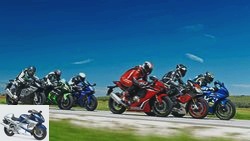
Super athlete
2017 super sports car in the country road comparison test
2017 superbikes
read more
Prices and offers of the very latest super athletes in Germany
1000PS marketplace app
The latest super bikes in price comparison
Fast, faster, the fastest – superbikes, the premier class in the motorcycle sector. Filled with technology of all kinds that have been tried and tested in racing, they are the pride of every manufacturer and at the same time set the benchmark for what is currently feasible in the field of motorcycle performance. Even if emissions standards pose major hurdles for the manufacturers and some legendary motorcycles have already had to believe in them, new, even sharper super sports cars are still presented year after year. Here you will find the hottest supersport bikes currently available on the used market: Prices for the latest superbikes Germany
Related articles
-
Supersport motorcycles in comparison test on the racetrack
Bilski 34 pictures Bilski 1/34 track test super athlete. Bilski 2/34 … The fact that he chose the Suzuki for this high-speed posing speaks for its …
-
Seven superbikes in the comparison test – country road
r-photography.info 37 pictures r-photography.info 1/37 Aprilia RSV4 RF, BMW S 1000 RR, Ducati Panigale V4 S, Honda CBR 1000 RR Fireblade SP, Kawasaki Ninja …
-
Comparison test of superbikes, part 1: Country road
Jorg Kunstle 36 pictures 1/36 Comparison test Superbikes: Aprilia RSV4 RF, BMW S 1000 RR, Kawasaki ZX-10R, Yamaha YZF-R1M. 2/36 …
-
7 superbikes in the racetrack test
r-photography.info, factstudio.de 14 pictures r-photography.info, factstudio.de 1/14 Aprilia RSV4 RF, BMW S 1000 RR, Ducati Panigale V4 S, Honda CBR 1000 …
-
Test of the Superbikes 2012 – The super athletes on the racetrack
Jahn 26 pictures Jahn 1/26 The super athletes: Aprilia RSV4 Factory APRC, BMW S 1000 RR, Ducati 1199 Panigale S, Honda Fireblade, Kawasaki Ninja ZX-10R, KTM …
-
Comparison test of superbikes part 2 – racetrack
51 pictures 1/51 The Kawa brake was transformed. She looked dull and lacked exact feedback. …
-
Comparison test 750 superbikes
Comparison test of 750cc superbikes The latest rumor that Suzuki had built a divine bike with the super light GSX-R, Kawasaki’s brand new ZX-7R was a …
-
PS Bridgestone Tuner GP 2016 – 1000 Superbikes in comparison test
fact 27 photos markus-jahn.com 1/27 Picture gallery, TunerGP: 1000 Superbikes in comparison. markus-jahn.com 2/27 Bartschat-Kawasaki ZX-10R. Lap time:…
-
fact 34 pictures fact 1/34 For the MOTORRAD issue 11/2015, the Supersport septet rode the “Masterbike 2015” at the great Lausitzring in Brandenburg ….
-
Comparison test of the 1000 super sports car
Jaime de Diego 38 pictures fact 1/38 Yamaha demands 14895 euros for their completely new R1 super sports car. fact 2/38 Even without ABS, the Fireblade would …